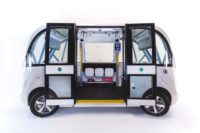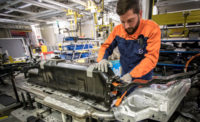STOCKHOLM, Sweden—Einride has launched a commercial version of its unmanned, electric heavy transport vehicle. The autonomous freight pod features an aerodynamic design and an iconic shape.
The 23-foot-long Pod has a load capacity of 15 standard pallets or 20 tons. Its 200-kilowatt-hour battery enables the vehicle to drive up to 124 miles between charges.
“We can already see a strong traction from the market to start using autonomous and electric transport,” says Robert Falck, CEO and founder of Einride. “The benefits are clear and we want to be the player in the market that can help our customers make the transition to a better future of transport happen.
“We started this journey in 2016 with a dream to build a better future through technology,” explains Falck. “Years of hard work and dedication from the whole team at Einride have made us the leader in autonomous electric transport (AET), and today we are taking the next step to bring our solutions to the world and ramp up the transition to a more sustainable future of transport.
“Most self-driving vehicles are designated by SAE J3016 levels of autonomy, ranging from purely assistive (level 0) to fully autonomous, able to drive anywhere on their own under any conditions (level 5),” Falck points out. “However, these standards rely on some level of human operation as a baseline.
“The Pod has no driver’s compartment whatsoever, so it was necessary for [us] to develop a proprietary methodology for describing the use cases for AET,” says Falck.
“The Pod is a completely novel vehicle, and therefore doesn’t fit into existing standards, even for cutting-edge technologies like autonomy,” claims Pär Degerman, chief technology officer at Einride. “We created the AET classification system based on use cases for a driverless, electric freight vehicle. With this approach, we are able to develop and scale our capabilities in the most common and appropriate use cases for freight, with the ultimate goal of automating as much of the transport network as possible.
“The AET classification system ranges from levels 1 to 5, and levels 1 to 4 are available for preorder based on individual business need,” explains Degerman. “AET 1 (fenced) is ideal for closed facilities with predetermined routes that are best suited for fully autonomous operation.
“AET 2 (nearby) includes closed facility operation, but adds the capability to traverse public roads over short distances between destinations,” Degerman points out. “Both AET 1 and 2 Pods are available for reservation now, and will begin shipping to customers starting next year.
“AET 3 (rural) takes the Pod’s functionality to the next level, allowing operation on backroads and less busy main roads between facilities, at a maximum operating speed of 45 kilometers per hour,” adds Degerman. “Finally, AET 4 (highway) includes fully autonomous operation on freeways and other major roads at up to 85 kilometers per hour.”
Two initial launch customers of Einride’s driverless vehicles include Lidl Sweden, a supermarket chain, and Oatly, a producer of plant-based milk and dairy products.



